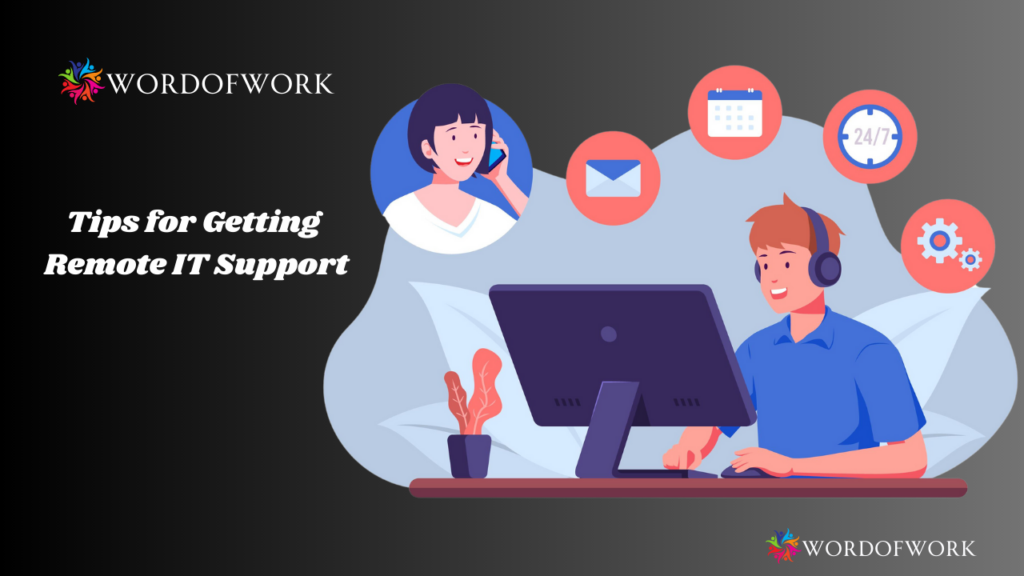Tips for Getting Remote IT Support: In today’s rapidly evolving digital landscape, the need for efficient and reliable IT support is paramount. With the rise of remote work and the increasing complexity of technology, accessing remote IT support has become a critical aspect of maintaining seamless business operations. Whether you’re a business owner, an employee, or a regular user facing technical glitches, these additional tips will help you navigate the world of remote IT support more effectively.

Table of Contents
Introduction: Tips for Getting Remote IT Support
Remote IT support has revolutionized the way technical issues are addressed. Whether it’s troubleshooting, software installation, or network configuration, remote support provides timely solutions without the need for physical presence.
Choosing the Right Remote IT Support Provider
Selecting a reputable remote IT support provider is crucial. Consider factors like experience, customer reviews, and the range of services offered. A reliable provider ensures prompt assistance when problems arise.
Clearly Define Your Technical Issues
When seeking remote IT support, articulating the problem clearly is essential. The more accurate and specific you are about the issue, the faster and more accurately the technician can diagnose and fix it.
Utilize Remote Monitoring Tools
Proactive monitoring tools can detect potential IT issues before they become critical. These tools track system performance, security vulnerabilities, and more, allowing support teams to address problems before they impact your operations.
Maintain Effective Communication
Effective communication with your remote IT support team is vital. Keep them informed about any changes in your systems or business operations. This collaboration ensures that the support team is always aligned with your needs.
Prioritize Cybersecurity
Security should never be compromised, even in remote IT support scenarios. Ensure that the support provider follows industry best practices to protect your sensitive data and systems from potential threats.
Remote IT Support for Businesses
For businesses, remote IT support offers scalability and cost-efficiency. It enables quick problem resolution, minimizes downtime, and allows internal teams to focus on strategic tasks.
Empowering Remote Employees
Equip your remote workforce with the knowledge to troubleshoot minor issues themselves. This empowerment can enhance productivity and reduce dependence on external support for every small glitch.
The Role of Documentation
Maintain a record of resolved IT issues and their solutions. This documentation serves as a valuable resource for future reference and contributes to the overall efficiency of your IT operations.
Ensuring Data Backup and Recovery
Remote IT support should include robust data backup and recovery solutions. This ensures that your critical data is safe and can be restored swiftly in case of any unforeseen data loss.
Remote Support for Software and Applications
Apart from hardware, remote IT support also extends to software-related problems. Whether it’s troubleshooting an application or assisting with updates, remote technicians can guide you through the process.
Understanding Service Level Agreements (SLAs)
Service Level Agreements outline the terms of service you can expect from your IT support provider. Understand the SLA thoroughly to know the response times and resolution procedures.
Managing Remote IT Costs
Cost-effectiveness is a significant advantage of remote IT support. By outsourcing your IT needs, you can save on expenses related to hiring and training an in-house IT team.
Staying Updated with Technology Trends
Remote IT support providers stay updated with the latest technology trends. Leveraging these advancements can give your business a competitive edge and enhance operational efficiency.
Conclusion
In the digital age, remote IT support bridges the gap between technical issues and effective solutions. By choosing the right provider, maintaining clear communication, and staying informed about technology trends, individuals and businesses can navigate the IT landscape seamlessly.
FAQs
- Is remote IT support as effective as on-site support? Remote IT support can be equally effective for a wide range of technical issues, especially when provided by experienced professionals.
- How can I ensure the security of my sensitive data during remote support? Reputable remote IT support providers implement stringent security measures to safeguard your data.
- What should businesses prioritize while choosing a remote IT support provider? Businesses should prioritize factors like reliability, experience, service range, and scalability when selecting a remote IT support provider.
- Can remote IT support assist with hardware-related problems? While remote IT support primarily focuses on software, some providers can guide you through basic hardware troubleshooting as well.
- How often should I update my systems to stay secure? Regular updates are crucial for maintaining security. Consult your remote IT support team to establish a suitable update schedule.
Remember, effective remote IT support not only resolves technical issues but also empowers you to make the most of your digital environment.
Explore The Insider’s Views for expert guidance and advice. Access a wealth of knowledge and enhance your tech journey today!

